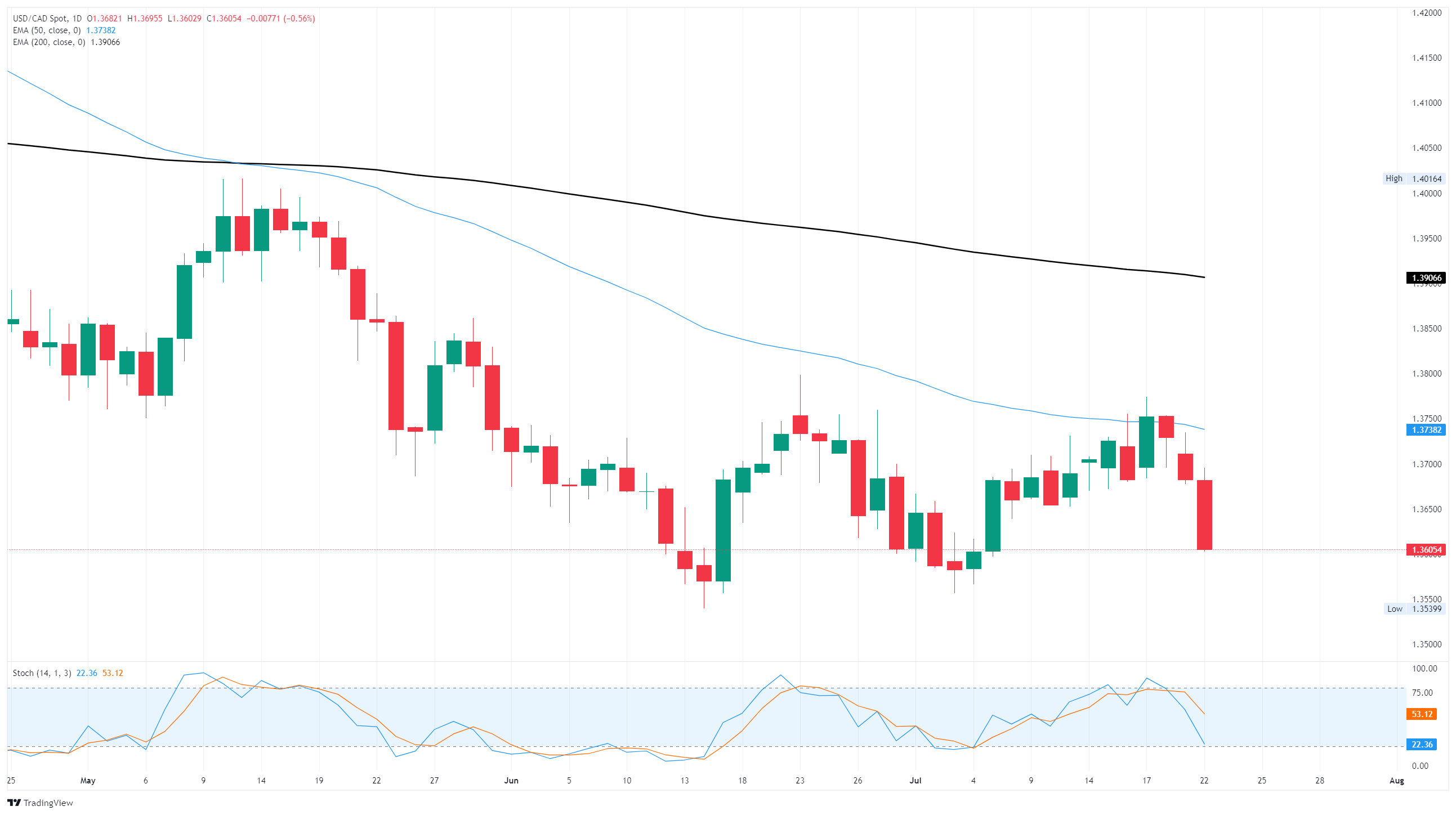Canadian Dollar climbs as Greenback losses pile on
- The Canadian Dollar got bolstered on Tuesday as USD bulls ease off the gas.
- A third straight day of DXY declines pushed the Loonie into multi-week highs.
- Canadian PM Carney remains open to US trade talks, but other deals are still in the works.
The Canadian Dollar (CAD) caught another breather on Tuesday, gaining ground against the weakening US Dollar (USD) and extending into its third straight day of firm gains. The Loonie is up around 1.25% against the Greenback from last week’s lows, pushing the USD/CAD pair down to the 1.3600 handle.
Canadian economic data remains strictly mid- to low-tier this week, keeping the Loonie at the mercy of headlines that largely focus on trade with the United States (US). Canadian Prime Minister Mark Carney reiterated Canada’s stance of cautious willingness to engage in trade talks with the Trump administration, but warned that Canada will continue to support its industries and seek additional trade deals with other countries.
Daily digest market movers: Canadian Dollar rises on continued USD weakness
- Despite fresh gains on Greenback selling pressure, the CAD remains trapped in near-term chart churn.
- USD/CAD has traded stubbornly within a choppy range since late May.
- Canadian PM Mark Carney reiterates Canada’s openness to US trade talks as long as they represent Canadian interests, a very high bar for the Trump administration to hit.
- US Dollar losses accelerated on Tuesday as President Trump continues his campaign against his own Federal Reserve Chair pick.
- Trump lacks the legal authority to terminate Fed Chair Jerome Powell’s position ahead of schedule, but legality has done little to stop Donald Trump’s moves during his second term.
Canadian Dollar price forecast
With the Canadian Dollar trending back into recent highs against the lagging US Dollar, the USD/CAD is poised to price in a messy triple bottom. The Greenback has been under intense selling pressure since Trump’s inauguration, and even the most ardent USD sellers need to be concerned about running too far, too fast into oversold territory.
USD/CAD daily candlesticks will run into stiff technical support from the 1.3580 to 1.3550 region. On the high side, a fresh bullish pivot will have to crack through the 50-day Exponential Moving Average (EMA) near 1.3740 to find sustained momentum.
USD/CAD daily chart

Canadian Dollar FAQs
The key factors driving the Canadian Dollar (CAD) are the level of interest rates set by the Bank of Canada (BoC), the price of Oil, Canada’s largest export, the health of its economy, inflation and the Trade Balance, which is the difference between the value of Canada’s exports versus its imports. Other factors include market sentiment – whether investors are taking on more risky assets (risk-on) or seeking safe-havens (risk-off) – with risk-on being CAD-positive. As its largest trading partner, the health of the US economy is also a key factor influencing the Canadian Dollar.
The Bank of Canada (BoC) has a significant influence on the Canadian Dollar by setting the level of interest rates that banks can lend to one another. This influences the level of interest rates for everyone. The main goal of the BoC is to maintain inflation at 1-3% by adjusting interest rates up or down. Relatively higher interest rates tend to be positive for the CAD. The Bank of Canada can also use quantitative easing and tightening to influence credit conditions, with the former CAD-negative and the latter CAD-positive.
The price of Oil is a key factor impacting the value of the Canadian Dollar. Petroleum is Canada’s biggest export, so Oil price tends to have an immediate impact on the CAD value. Generally, if Oil price rises CAD also goes up, as aggregate demand for the currency increases. The opposite is the case if the price of Oil falls. Higher Oil prices also tend to result in a greater likelihood of a positive Trade Balance, which is also supportive of the CAD.
While inflation had always traditionally been thought of as a negative factor for a currency since it lowers the value of money, the opposite has actually been the case in modern times with the relaxation of cross-border capital controls. Higher inflation tends to lead central banks to put up interest rates which attracts more capital inflows from global investors seeking a lucrative place to keep their money. This increases demand for the local currency, which in Canada’s case is the Canadian Dollar.
Macroeconomic data releases gauge the health of the economy and can have an impact on the Canadian Dollar. Indicators such as GDP, Manufacturing and Services PMIs, employment, and consumer sentiment surveys can all influence the direction of the CAD. A strong economy is good for the Canadian Dollar. Not only does it attract more foreign investment but it may encourage the Bank of Canada to put up interest rates, leading to a stronger currency. If economic data is weak, however, the CAD is likely to fall.
